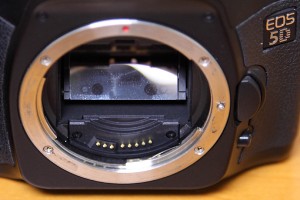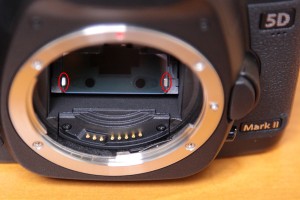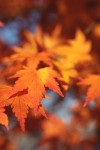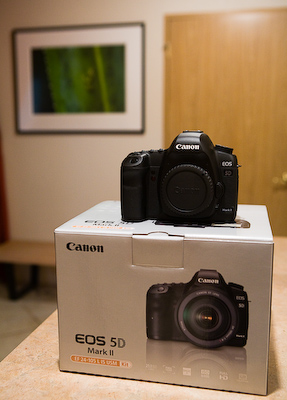For most of the past year, I’ve been using a Canon 1Ds Mark III as my primary camera. It provides phenomenal image quality (when used with the right lenses), and it handles really well. But it’s also REALLY expensive. So when Canon announced that the new 5D Mark II would have the same 21 megapixel resolution at a third of the price, I knew that I had a decision to make. Was it time to sell my 1Ds3 and “downgrade” to the 5D2, hopefully freeing up several thousand dollars that I could save or invest in lenses, etc.
I knew that I’d be giving up some of the professional features that the 1-series cameras have, and that the new 5D is actually better in some areas, so I put together a comparison based on the features that matter to me. Those may not be the same things that matter to you, so I’ll start with a few words about the kinds of subjects that I shoot. I mostly do landscape and wildlife photography, plus some outdoor lifestyle images of people and dogs. I’ll talk more about how each camera feature relates to specific subject matter below.
| Feature |
1Ds Mark III |
5D Mark II |
Comments |
| Sensor |
21 megapixel CMOS |
21 megapixel CMOS with improved noise procesing circuitry and new color filters featuring increased light transmission |
The high-resolution sensor is the biggest reason for why I originally bought the 1Ds3. It’s allowed me to make amazing prints up to 36″ x 24″. It’s key that the 5D2 retains that same level of detail. In fact, the changes to the sensor should make it even better at high ISOs, although we won’t know for sure until we see samples from production cameras. If it can approach the low-light capabilities of the Nikon D3 and D700, that would really be something! But I’m not holding my breath. There’s also been some comment that the new sensor offers increased dynamic range, but we’ll have to wait and see on that one too. |
| Viewfinder |
Full-frame, 100% coverage, 0.76x magnification, eye-piece shutter, diopter adjustment hidden behind eyecup |
Full-frame, 98% coverage, 0.71x magnification |
I love the viewfinder on the 1Ds3. It’s the best I’ve used on any DSLR (although I hear the Sony A900 is even better!). It’s big, it’s bright, and it’s easy to use with glasses. I’ll miss the 100% coverage a little, as it’s nice to be able to compose right out to the edges of the frame without having to check the LCD. And I’ll miss the increased magnification too, since I find that it makes it easier to compose quickly and follow action within the frame. I like having the little lever for sealing off the viewfinder during long exposures. It’s a more practical solution than the little rubber cap Canon supplies attached to the neck strap, which requires removing the eyecup. Maybe I’ll try making my own cover that will slip over the eyecup. Finally, it’s nice that 1Ds3 protects the diopter from accidental adjustment by hiding it behind the eyecup…at least, that’s what I used to think, until I accidentally changed my diopter while changing eyecups in order to use a raincover. So either way, I still need to tape it down for safety. Canon, how about some hind of mechanical lock to prevent accidental diopter changes? But really, these are all quibbles. I owned the original 5D, and I was pretty happy with its viewfinder. |
| Weather sealing |
Canon’s standard pro-level weather sealing. |
More sealed than the original 5D, less sealed than the 1Ds3. |
The good news is that Canon has added some weather sealing to the 5D2, the bad news is that it’s less well sealed than the 1Ds3, and Canon is being vague about what that means in practice. I like having weather sealing, especially after discovering how hard it is to change lenses when using something like the Aquatech SS-200 raincover. But it’s rare that I’m actually going to be standing out in the rain shooting. When I do, it’s probably for wildlife, and I’ll be using a long telephoto with a rain cover. |
| Autofocus |
Fast, with many cross-type points, more coverage |
Less fast, fewer points overall, only center point is cross-type |
Okay, this is the feature that I am really going to miss. I’ve used the original 5D, and it’s AF system just was not adequate for fast moving subjects. Unfortunately, Canon has kept it unchanged for the new model. I do a lot of wide angle photography of dogs, which is actually quite demanding in terms of autofocus. The dogs don’t stay still for long, especially if they are playing. I choose to always use a single focus point, and I use “thumb focus” using the separate AF-On button. The real weakness of the 5D comes into play when trying to compose an off-center image, like if you want to place your subject using the rule of thirds. With the 1Ds3, the AF points are widely spaced enough that I can usually put a point where I want my subject, then hold my composition while I wait for the peak moment. Since the 5D2 has less coverage, I’m often forced to recompose or resort to manual focus. If I am able to get an outer point on the subject, I find that the cross-type points of the 1Ds3 usually focus faster than those of the 5D. |
| Custom modes |
None |
3 custom settings on the mode dial |
This is a nice feature addition on the 5D2. I often have a default group of settings for a particular kind of shooting, so I’m looking forward to saving those into the custom groups. For instance, if I’m going to be taking landscape images with a tripod, I need to turn on mirror lock-up and set the drive mode to 2-second timer. |
| ISO range |
50-3200 |
50-25600 |
On the 1Ds3 I prefer not to go above 1600 ISO. I’ll be really excited if 3200 or 6400 on the 5D2 look as good as 1600 on the 1Ds3, but we’re going to have to wait and see. |
| Video |
None |
1080p at 30 fps |
I’ve always been interested in film and video, so I think this will be fun to experiment with. Early reports indicate that the video quality is pretty incredible, and it’s certainly going to shake things up in the industry. |
| LCD |
3″, 230,000 pixels |
3″, 920,000 pixels |
The new screen on the 5D2 should be a HUGE improvement. I’ve been jealous of screens like this since the Nikon D3 was announced. If you scroll about halfway down this page, DPReview has a good section where they explain why these new screens are so much nicer than the older ones. The 5D2 screen should be really useful when checking focus or trying to maximize depth of field in LiveView. |
| Drive speed and buffer |
5 FPS, 12 RAW images |
3.9 FPS, 13 RAW images |
The buffers are about the same size, and I won’t miss the extra frame per second, except maybe for some wildlife work. |
| Responsiveness |
40-55ms shutter lag, 80ms mirror blackout |
73ms shutter lag, 145ms mirror blackout |
The 1Ds3 is noticeably snappier than the original 5D, although the 5D is fast enough that I don’t generally feel that I’m missing shots because of shutter lag. It just takes slightly more anticipation of the moment that you want to capture. |
| Battery |
Larger capacity, also physically larger and heavier |
Smaller, lighter, cheaper |
After my experience with using the 1Ds3 for star trail photography, I came to appreciate having the larger capacity battery. But otherwise this is a win for the 5D2…the smaller size and weight will be a benefit when travelling, especially the fact that the charger is so much smaller. |
| Size and weight |
3.1 pounds w/battery, pro-style body w/integrated vertical grip |
1.96 pounds w/battery |
This one goes to the 5D2. I sometimes like using the integrated vertical grip of the 1Ds3, but as a guy who owns a titanium spoon, I’m more excited about saving over a pound when backpacking with my 5D2. Plus the smaller body style is a little less conspicuous when shooting in public. |
| Custom function to use SET as ISO button |
Yes |
No |
Early reports are that the 5D2 is missing the 1Ds3’s custom function that allows you to use the SET button for changing ISO. Personally, I find this the easiest way to change ISO when you have the camera to your eye, and I hope Canon adds this option with a future firmware upgrade. |
| Voice memo |
Yes |
No |
Even though the 5D2 has a microphone for movies, Canon neglected to include the voice memo feature. This is unfortunate, but it’s something that I only need occasionally. I guess I could always record a movie of myself talking to the camera 🙂 |
| Price |
$8000 list, now down to about $7200 at B&H |
$2700 list, no discounts yet |
Obviously this is a big one. I think Canon must be scared of Sony’s new A900 to have introduced the 5D2 at such a (relatively) low price. Given that used 1Ds3’s seem to be selling in the mid-5K range, you can still have quite a bit of cash leftover if you switch. Of course, that also means you took a pretty big depreciation if you paid list. I was lucky to get a good price on my 1Ds3 when I bought it new, but if I hadn’t I might be more reluctant to give up those pro-spec features that I already paid for. Ultimately, my guess is that the days of the $8000 flagship camera may be over. I can’t really see people paying much more than $5000 for the 1Ds Mark IV, unless it turns out to have some super magic new sensor. I don’t think resolution alone will be enough to justify such inflated prices in the future. 21 megapixels already challenges my lenses and lets me make the biggest prints that I want to. Maybe we’ll eventually get back to a point that is more like film cameras, where they all have similar sensors and models are differentiated solely by other features. |



